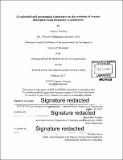| dc.contributor.advisor | Juan Pablo Canales and Robert A. Sohn. | en_US |
| dc.contributor.author | Horning, Gregory (Gregory William) | en_US |
| dc.contributor.other | Woods Hole Oceanographic Institution. | en_US |
| dc.coverage.spatial | l------ | en_US |
| dc.date.accessioned | 2017-05-11T19:55:07Z | |
| dc.date.available | 2017-05-11T19:55:07Z | |
| dc.date.copyright | 2017 | en_US |
| dc.date.issued | 2017 | en_US |
| dc.identifier.uri | http://hdl.handle.net/1721.1/108908 | |
| dc.description | Thesis: Ph. D., Joint Program in Oceanography/Applied Ocean Science and Engineering (Massachusetts Institute of Technology, Department of Earth, Atmospheric, and Planetary Sciences; and the Woods Hole Oceanographic Institution), 2017. | en_US |
| dc.description | Cataloged from PDF version of thesis. | en_US |
| dc.description | Includes bibliographical references (pages 104-115). | en_US |
| dc.description.abstract | This thesis investigates the evolution of the oceanic lithosphere in a broad sense from formation to subduction, in a focused case at the ridge, and in a focused case proximal to subduction. In general, alteration of the oceanic lithosphere begins at the ridge through focused and diffuse hydrothermal flow, continues off axis through low temperature circulation, and may occur approaching subduction zones as bending related faulting provides fluid pathways. In Chapter 2 1 use a dataset of thousands of microearthquakes recorded at the Rainbow massif on the Mid-Atlantic Ridge to characterize the processes which are responsible for the long-term, high-temperature, hydrothermal discharge found hosted in this oceanic core complex. I find that the detachment fault responsible for the uplift of the massif is inactive and that the axial valleys show no evidence for faulting or active magma intrusion. I conclude that the continuous, low-magnitude seismicity located in diffuse pattern in a region with seismic velocities indicating ultramafic host rock suggests that serpentinization may play a role in microearthquake generation but the seismic network was not capable of providing robust focal mechanism solutions to constrain the source characteristics. In Chapter 3 I find that the Juan de Fuca plate, which represents the young/hot end-member of oceanic plates, is lightly hydrated at upper crustal levels except in regions affected by propagator wakes where hydration of lower crust and upper mantle is evident. I conclude that at the subduction zone the plate is nearly dry at upper mantle levels with the majority of water contained in the crust. Finally, in Chapter 4 I examine samples of cretaceous age serpentinite sampled just before subduction at the Puerto Rico Trench. I show that these upper mantle rocks were completely serpentinized under static conditions at the Mid-Atlantic Ridge. Further, they subsequently underwent 100 Ma of seafloor weathering wherein the alteration products of serpentinization themselves continue to be altered. I conclude that complete hydration of the upper mantle is not the end point in the evolution of oceanic lithosphere as it spreads from the axis to subduction. | en_US |
| dc.description.statementofresponsibility | by Gregory Horning. | en_US |
| dc.format.extent | 155 pages | en_US |
| dc.language.iso | eng | en_US |
| dc.publisher | Massachusetts Institute of Technology | en_US |
| dc.rights | MIT theses are protected by copyright. They may be viewed, downloaded, or printed from this source but further reproduction or distribution in any format is prohibited without written permission. | en_US |
| dc.rights.uri | http://dspace.mit.edu/handle/1721.1/7582 | en_US |
| dc.subject | Joint Program in Oceanography/Applied Ocean Science and Engineering. | en_US |
| dc.subject | Earth, Atmospheric, and Planetary Sciences. | en_US |
| dc.subject | Woods Hole Oceanographic Institution. | en_US |
| dc.subject.lcsh | Lithosphere | en_US |
| dc.subject.lcsh | Ocean circulation | en_US |
| dc.subject.lcsh | Earthquakes | en_US |
| dc.title | Geophysical and geochemical constraints on the evolution of oceanic lithosphere from formation to subduction | en_US |
| dc.type | Thesis | en_US |
| dc.description.degree | Ph. D. | en_US |
| dc.contributor.department | Joint Program in Oceanography/Applied Ocean Science and Engineering | en_US |
| dc.contributor.department | Woods Hole Oceanographic Institution | en_US |
| dc.contributor.department | Massachusetts Institute of Technology. Department of Earth, Atmospheric, and Planetary Sciences | |
| dc.identifier.oclc | 986241291 | en_US |
